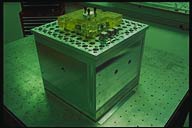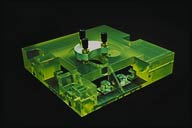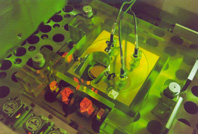
Figure 1: The LORS stage.

Figure 2: Zerodur metrology frame, with STM head.

Figure 3: Inside the SAMM.



Our design incorporates closed-loop control of a piezoelectric tube scanner, which guides a z-position sensor over the surface of the sample. We will use a miniature piezoelectric quartz tuning fork as the sensing element. As shown in various experimental studies, such a tuning fork may be used to detect atomic-scale surface features. In operation, we electrically excite the fork at its resonant frequency (2^15 Hz). When brought within roughly 10nm of the sample, near-surface atomic forces mechanically damp the fork's oscillations, altering the fork's electrical characteristics. While scanning in the X-Y plane, we will adjust the tube scanner's driving voltage to maintain a fixed fork impedance, thereby establishing a constant tip-sample separation. To create a topographic image of the sample, we simply record the relative extension or contraction of the scanner at each X-Y sampling point. To close the loop on the scanner, the head assembly will include a set of three capacitive gauges.